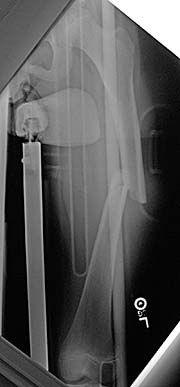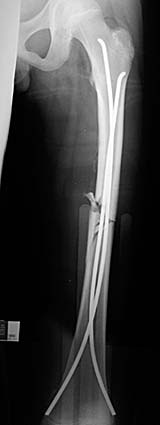Nancy nailing: a pediatric innovation for contemporary society
Elastic stable intramedullary nails provide easier management for fractures, less strain for families.
Click Here to Manage Email Alerts
 Using elastic stable intramedullary nails for pediatric upper and lower extremity fractures has markedly changed the state of fracture fixation in the past two decades. A key change has been shorter immobilization time and hospital stays while still achieving and maintaining anatomic reduction. However, like many new developments in the orthopedic community, these advances have not been without controversy and cost.
Using elastic stable intramedullary nails for pediatric upper and lower extremity fractures has markedly changed the state of fracture fixation in the past two decades. A key change has been shorter immobilization time and hospital stays while still achieving and maintaining anatomic reduction. However, like many new developments in the orthopedic community, these advances have not been without controversy and cost.
Elastic stable intramedullary nailing (ESIN) is also known as Nancy nailing in reference to the work of Jean-Paul Metaizeau in the pediatric hospital in Nancy, France. Using the ESIN concepts of the Romanian surgeon Firica, Metaizeau demonstrated inserting two flexible curved rods into the relatively straight intramedullary canal produced opposing forces, which would both reduce and stabilize mid-shaft femoral fractures in children. Along with Ligier and Prevot, Metaizeau published his findings in the early 1980s.
Long hospitalizations
Surgeons had few treatment options for femoral fractures in children prior to the developments of the ESIN concept.
For years, the standard of care for pediatric femur fractures involved long weeks of traction followed by more weeks of spica casting. According to Alvin H. Crawford, MD, director of pediatric orthopedics at Cincinnati Children’s Hospital Medical Center, “It was a long hospitalization period followed by a long at-home period, which required a lot of care.” Crawford, a member of the Orthopedics Today editorial board, said it was a very effective treatment, with few complications. However, it produced a long separation with psychological distress.
Operative fixation with plating became popular and still is the standard of care in some areas. However, some surgeons believe that plating is a big operation with large incisions. Later, the plated femur may be susceptible to fracture above or below the plate.
Courtesy of Dennis R. Wenger |
External fixators are also popular, but if not used properly, they could lead to refractures.
Innovative on many fronts
The concept of ESIN came to the pediatric orthopedic community at a time that was ripe for change. As the medical community was evolving toward more expeditious and cost-effective treatments, society itself was changing. “In the old days there was always someone at home to care for the child that you sent home in a cast,” said Carl L. Stanitski, MD, professor of orthopedic surgery at the Medical University of South Carolina. “These days for single parents, or where both parents work, or for families that do not have extended members nearby, it is very difficult to care for one of these children in a spica cast — it has a huge social impact on the family.”
Dennis Wenger, MD, of Children’s Hospital — San Diego, said ESIN developed in an era when it became clear that children’s fractures needed a more perfect reduction. “Papers by people like Blount from Milwaukee, suggested that children’s fractures didn’t need to be very accurately reduced because they would usually remodel and straighten themselves. There was a slow recognition that that would not always be true, particularly in older children. In many cases orthopedists were overplaying their cards, by putting them in a simple cast and then in the end, the bone wasn’t as straight as they thought it would be.” Wenger is a member of the Orthopedics Today editorial advisory board.
Cost effective?
Although ESIN results in reduced costs because of shorter hospitalization, the operative costs can be high, especially if the nails are removed.
Also, there may be other sociological costs. “It is sort of good news/bad news situation,” Crawford said. “The kid is home in three days; however, in a marginal or a single parent family with a few children that is barely making it, that is not a lot of time for a parent to mobilize some forces, get a support network together. If the parent has no one, a marginal job will probably be history.”
The procedure, which is quickly becoming the standard of care in the United States for femur and forearm fractures, is most effective when used on the appropriate patients. Most orthopedists agree that patients aged 6 to 12 years, who are a bit on the lean side and have mid-shaft fractures are the best candidates. Comminuted or spiral fractures or those that are too proximal or distal also are well suited for the Nancy nailing.
By far, the largest controversy surrounding ESIN is whether or not to remove the nails following fracture healing. The nails are designed with flared tips, which aid in removal. “In the old days [the patients] would get irritation around the edges of the rods, especially around the knee, but now we have newer techniques where we don’t bend them at such an angle,” Stanitski said. “I think the fears and concerns about the metallurgy of the old days are much less now than they were before.”
Wenger believes they should be removed. “I don’t believe that there is enough evidence for a surgeon to say ‘I know they do not need to be removed.’ From my view point, if you are pounding them all the way in and telling the parents that they don’t have to come out, … you are providing advice which is not yet documented by medical literature. Particularly in a younger child with a femur fracture, growth can make the rod end more prominent, with risk for fracture. The people in France who started it say take them out, and we agree.”
Scott Hoffinger, MD, director of orthopedics at Children’s Hospital in Oakland, Calif., believes the nails can, in most cases, be retained. “We found several years ago that orthopedists were not having their own hardware removed. We take it out of our patients, but we leave it in ourselves,” he said. “We also saw a couple of papers that showed taking out the hardware led to a higher refracture rate and we found that there was no documented downside to leaving them in. Our data show that 75% of patients followed for up to five years had no symptoms and did not require removal.”
|
|
|
Hoffinger said he has found that the rod tips annoy about 25% of his patient’s with the nails. “So you take it out of them, and leave them in the others and they are fine.”
He said surgeons are caught in a Catch-22 situation based on their beliefs. “If you decide you are going to take them out, you leave them prominent and they hurt the child so you have to take them out. If your desire is to retain them, you cut them short and you drive them in and they are harder to get out, so you leave them in.”
Crawford said if you leave the nails in, as the child grows the nails might migrate up and possibly stick out of the femur and produce a stress riser. “That is something to be concerned with,” he said. “We like to take them out, it is just what we do, and it does not mean that it is right or wrong.”
Future generations of the devices may make the removal discussion a moot point. “It would be wonderful to have a bioabsorbable or biodegradable implant that would not create an excessive tissue reaction and response to the degradation process. Whether that will come to pass one doesn’t know,” Stanitski said.




